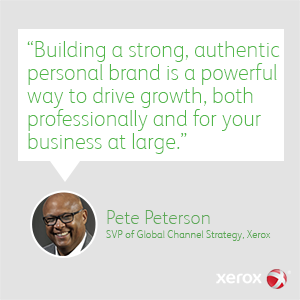 Branding is a fundamental principle of marketing. When it comes to valuation, the brand itself can be worth more than the products or services it represents. But with the pervasiveness of social media blurring the line between our business identities and our personal lives, it’s no longer enough to build just a strong business brand. Today’s sales leaders need a strong -and visible – personal brand as well.
Branding is a fundamental principle of marketing. When it comes to valuation, the brand itself can be worth more than the products or services it represents. But with the pervasiveness of social media blurring the line between our business identities and our personal lives, it’s no longer enough to build just a strong business brand. Today’s sales leaders need a strong -and visible – personal brand as well.
Forbes.com writes, “Over the past five years, the number of CEOs jumping on the social media bandwagon to promote their personal brand has dramatically increased. Corporate leaders…are finally realizing what their employees and customers already know: using social technologies to engage with customers, suppliers and their own employees enables companies to be more adaptive and agile.”
“BRANDfog’s 2016 Social Media Survey, which polled 500 U.S. employees in diverse companies, discovered that 75% of respondents believe that C-suite social media engagement makes a company brand seem more honest and trustworthy.”
The rise of social media with its ability to offer real-time interactive feedback has forever altered your customers’ expectations. Millennials in particular – and it is worth noting that only 7% of millennials identify themselves as brand loyalists – expect a personalized experience and want to have a social relationship with you and your business, not just a transaction.
In other words, when you meet a new sales prospect, they are going to research more than just your company and your product. They’re going to research you. When they search for you on LinkedIn or other social channels, what will they find? Or will they find anything at all?
I collaborated with our own internal social media and sales teams and combined their expertise with what I’ve learned about building my own brand – both from industry experts and my personal experience – to bring you these insights on how to build your personal brand, and why it’s so important to your success as a sales leader.
Have a Strong LinkedIn Profile
The value of LinkedIn for building sales and generating leads is often overlooked, mainly by people who aren’t using it well. With more than 460 million members across all industries, LinkedIn is an excellent resource for channel partners who are searching for prospects. However, successfully generating demand means forging connections with those prospects and leveraging them properly.
It is a difficult step that can sometimes feel like “cold calling”, especially when it’s done without finesse. The Channel Connection blog published a great in-depth piece about creating demand by increasing your LinkedIn connections here, and it’s a great place to start crafting your profile.
6 Ways Partners Can Generate More Demand by Increasing LinkedIn Connections – LinkedIn has become a rich watering hole for channel partners to identify prospects across all industries. However, in order to successfully generate demand, connecting with those prospects is key.
Still not convinced of the value of LinkedIn? This powerful post from sales industry expert Larry Levine details why every sales leader should have a strong LinkedIn profile, and just what it can do to help you grow your sales. Levine writes, “Connections create the opportunity to build relationships. It’s these relationships that will lead your clients, prospects, and peers to become more attentive to your brand. One of the best ways to establish these professional connections is through LinkedIn.”
Engage in Social Listening
Every day, millions of consumers take to social media to voice their opinions about brands, products, and services, and to find out what others are saying. When you’re building your own brand, it’s easy to start navel-gazing and get caught up in the creation of your own identity. Before you even think about participating in the social conversation, you first need to listen.
Effective social engagement and personal branding are about talking with your audience and making a real connection, not talking at them. Social listening means finding and monitoring the interactions people are having with your business and industry online, and it’s essential to crafting a personal brand that will resonate with your target audience. As Xerox’s Head of Digital Mastery, Andy Hill, explains in this post, “For channel partners, social media is a mechanism for generating demand, influencing buying decisions, and gaining competitive intelligence.” And it begins with listening.
How to Use Social Listening to Boost Customer Experience – Social listening can help you use these conversations to grow your business and improve your customer experience by helping you shape your content strategy, uncover growth opportunities, and discover insights you can’t access any other way.
While there are numerous ways to help the listening process, it really just begins with monitoring keywords, hashtags or phrases.
Search social media platforms for:
- Your business name
- The names of your competitors
- The brands that you sell
- The product names you sell
- Product specific terminology your prospects might use such as “all in one printer”, “MFP”, or “managed print services”
Next, you need to find your existing customers. Go to their website today, look for their social media badges and capture the URLs for their:
- LinkedIn company page
- Company Twitter handle
- Facebook company page
- Google Plus page
- Blog page
Read the full article on social listening here, and learn more about how to identify growth opportunities, and finally, how to use what you’ve learned to help shape your social persona or brand.
Know Where to Play
Any successful marketing strategy starts by figuring out how to best allocate the resources at your disposal, and that holds true for your personal brand as well. You don’t want to find yourself engaging in the social equivalent of spray and pray marketing. You need to carefully evaluate which social channels are right for the product or service you represent, and where you’re going to find the most promising prospects.
- Define your goals. Depending on the role you play on your sales team, you may be using your personal brand to interact with new prospects, or to motivate and engage with your existing sales teams. Identify your goals, then use social listening to help you find your audience. There are plenty of paid and free tools available to help you if you feel like you aren’t hitting the mark on your own.
- Know what kind of content works best for you. If you have strong writing skills and a clear thought leadership position, then fresh, original content is going to be comfortable and manageable for you. If that’s not yet in your wheelhouse, find social influencers whose ideas and style resonate with your own and follow them. Reposting and sharing curated content is a strategy every marketer uses, and you can, too.
I personally feel that LinkedIn is a must for every sales team. Xerox channel partners have access to our exclusive partner-only LinkedIn group. For print providers at large, these five LinkedIn groups provide a great forum for engaging warm prospects.
5 LinkedIn Groups Where Print Providers Should Be Active – LinkedIn groups allow you to connect and discuss specialized topics with like-minded people – people who often make ideal clients. Engaging with them in a forum where you share the same interests is a powerful way to create warm prospects.
Be Authentic
Of all the approaches we’ve discussed, this one is the most important to me and comes most directly from my own experience. The best salespeople are the ones who form strong connections by taking the time to get to know their customers and their needs. The same is true of business leaders. The authenticity that helps you forge connections in real life will also help you build a personal brand that will resonate with your audience.
Building a brand for the sake of itself will always backfire. Savvy audiences can spot and will unequivocally reject a crafted persona (not to mention that it’s also difficult and miserable to try to maintain one). Know your approach to sales and leadership in and out, and be true to it in all your social interactions.
Be consistent in the type of content you post and engage with, and make sure it’s authentic to both how you approach your business and your life. Your credibility and reputation are the most valuable marketing tools you’ll ever use, so build them carefully.
In today’s digital marketplace, there is little distinction between who we are and what we do. Building a strong, authentic personal brand is a powerful way to drive growth, both professionally and for your business at large.
Keep following my blog series for more insights on topics like motivating your sales teams, building a strong bid support team, and more.
 Become a Xerox Channel Partner
Become a Xerox Channel Partner
Ready to become a Xerox Channel Partner? Contact your Xerox account manager or review the Xerox Global Partner Program and apply to become a Xerox channel partner today to find out how we will help grow your business.
Join our Xerox Channel Partners LinkedIn Community
Looking for more marketing tips and insights from Xerox Agents, Concessionaires, and Document Technology partners from across the globe? Join our private Xerox Channel Partners LinkedIn Group.
Share this on Twitter!
Tweet: A strong, authentic personal brand can become a key growth driver: https://ctt.ec/ipWDn+ via @XeroxPartners
Subscribe to the Channel Partner Connection and receive email updates when we publish a new article.[wysija_form id=”1″]



